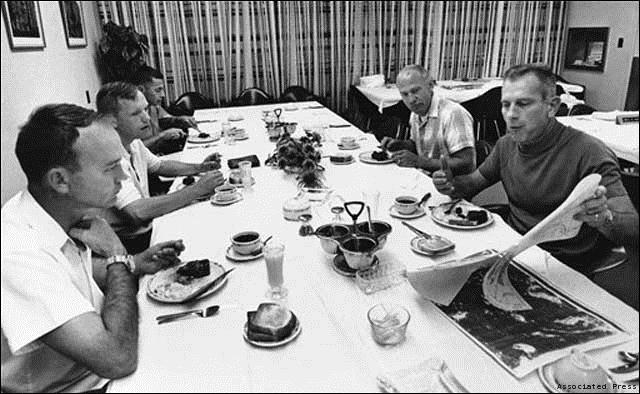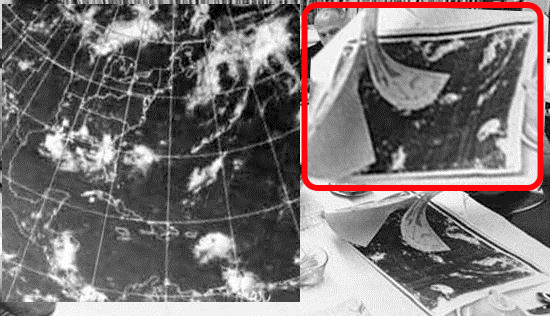4.3 Apollo 11 - Introduction
After the full dress rehearsal of Apollo 10 came the main event. Given the dramatic images sent by Apollo 10, it could be argued that this mission was less visually impressive. The crew spent most of the time on the lunar surface inside the LM, and did not venture far from it when they did finally emerge. Most of the photographs taken are of the lunar surface either from the ground or from orbit It is, nonetheless, the most historic of the Apollo missions, for obvious reasons.
The mission itself commenced with the launch on July 16th 1969. The crew entered lunar orbit on the 19th, after which the Aldrin & Armstrong entered the LM and departed for the lunar surface on the 20th, landing at 20:17 GMT. The crew set foot on the moon at 02:55 on the 21st, and left it for the safety of the LM at 05:11. The lift off back to the CSM was at 17:54, and the two craft were reunited at 21:35. TEI was at 02:55 on the 22nd, and the crew finally splashed down on the 24th.
During the mission they used 9 magazines to take 1408 images and made 7 TV broadcasts (not including the transmission from the moon itself). Several weather satellites are available from the time of the mission: NIMBUS, ESSA 8 & 9, ATS-1 and ATS-3.
The NIMBUS data can be found here. This volume shows visible images from the Image Dissector sensor, and day & night infra-red images. The best quality NIMBUS image from any given day will be used (though none of the NIMBUS images are particularly clear). The Australian Bureau of Meteorology kindly supplied a photomontage of 3 NIMBUS frames covering Australia. High resolution and medium resolution infra-red (HRIR and MRIR) images are also available from scanned negatives found here. These will be used, wherever possible, instead of the poor quality images originally used in this report.
In a recent find this website revealed the release of NIMBUS 3 Image Dissector Camera data on the National Snow and Ice Data Center website. The site allowed ftp access to both large size TIF images of better quality that those linked to above, as well as the individual ‘tiles’ that make up the image. Where possible, these will be given in the text in addition to the existing images. They have continued this work by looking at ESSA imagery, and kindly supplied some images relating to Apollo 11, which will be added for comparison. I have saved the documents here.
ESSA 9 data can be found here, hosted by the HATHI trust. I’ve compiled the relevant images into a single document here.
The ATS images have been found in from a variety of sources. A search for ATS-3 images found this one for July 17th on Photobucket and a partial image for July 18th can be found in a research document here. The University of Wisconsin generously sent 2 images from July 20th and 21st, and an ATS-3 image for July 22nd can be found in the Monthly Weather Review Vol 100 No 10. An ATS-1 (and ESSA 8) image for July 22nd can be found here. A more complete ATS-3 source is available here, but is generally of poorer quality. The other, better quality, ATS images will be used where possible.
An unnamed satellite contributes a further picture for July 21st in a document examining the first 5 years of the environmental satellite programmes in this TIROS report. An ESSA 8 image of tropical storm Claudia was uncovered in the Eastern Pacific 1969 Hurricane season report, as well as good quality images of Hurricane Bernice from July 16th. The Mariner's Weather Log Vol 13 provides a better quality ESSA 9 image of North America from July 22nd . This MSc thesis BOMEX study provides more examination of ESSA 9 images specifically in the Caribbean from almost all the Apollo mission, and larger scale images from the same study can be found here.
This 1973 report contains strips of ATS-3 images, one set of which covers July 18th, and is therefore included in the next section. We have a few more ATS images here that can add more details in subsequent sections.
These documents are mentioned not just as potential sources for discussion but also for the indication they provide that the data from the satellites were not hidden away – they were available for use by anyone who cared to look at them. Another example is this publication, which contains a number of NIMBUS images taken during the mission. I’ll also be making use of the digitally recovered ESSA and NIMBUS data discussed in Chapter 2 and making 3D reconstructions where possible.
The Apollo images used will be the high quality versions found at the Apollo Image Atlas and the Apollo Lunar Surface Journal ALSJ. Newer resources are the Project Apollo Flickr Archive and March to the Moon sites, and these may also get used where appropriate. Some images are not displayed on the ALSJ, but their links can be deduced from those that are. Despite the obvious and understandable focus on the lunar surface, the crew did manage to capture a number of significant images of Earth both on the way to, on the surface of, and back from, the Moon.
Before proceeding to the analysis, there is an interesting aside concerning the satellite data covering the mission. That satellite data was available for the crews has already been discussed, and one example of that comes from images of the crew’s final breakfast before departure, during which flight director Deke Slayton gives them a final briefing. Video and still images exist of that breakfast, and the image in figure 4.3.0.1 shows that part of the briefing covered the weather at Houston.

